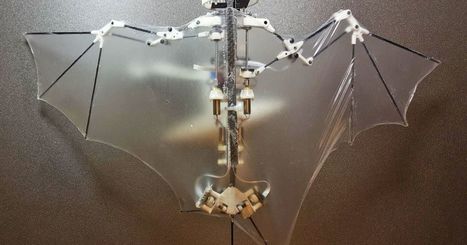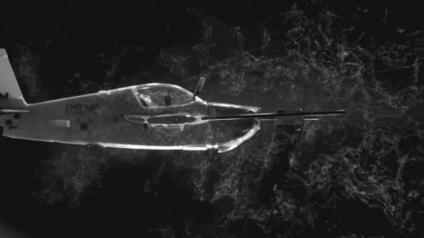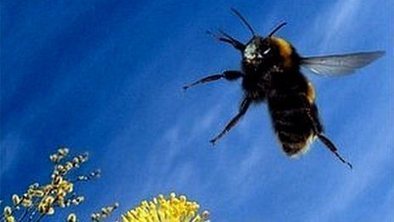 Your new post is loading...
 Your new post is loading...
"Ribbon halfbeak are a species of fish with the ability to fly above the sea surface - but unlike true 'flying fish', they lack the necessary hind wing fins. So how do they fly? Dr Yoshinobu Inada from Tokai University, Japan says, "Investigating the design of ribbon halfbeak could provide useful information for the optimal design of tandem wing airplanes."
Plenty of birds fly vast distances on their migratory trips around planet Earth. But the most amazing of all might the frigate bird, which can stay aloft for two months straight without landing or resting. How the heck do they do that?
A team of biologists led by Henri Weimerskirch at the French National Center for Scientific Research just announced the results of a major new study on great frigates (Fregata minor), these fascinating seabirds native to the central Indian and Pacific Oceans. Using super-lightweight GPS trackers, the biologists followed four dozen birds from 2011 to 2015, some for up to two years continuously. What they found was astonishing. The birds could stay aloft for up to 56 days without landing, gliding for hundreds of miles per day with wing-flaps just every 6 minutes, and reaching altitude of more than 2.5 miles.
"The next time you see a graceful, dramatic video shot by a camera drone, you may have a swan to thank for the absence of any jittery footage. Stanford University researchers aredeveloping camera suspension technology inspired by whooping swans, whose heads remain remarkably still even when they're making aggressive in-flight maneuvers. Thanks to a blend of high-speed video and computer modeling, the scientists discovered that the swan's neck acts much like a vehicle's suspension, passively countering the effects of flapping wings or headwinds."
The new robot uses adaptive morphology inspired by the common vampire bat, Desmodus rotundus, meaning that the wings have been actuated using a foldable skeleton mechanism covered with a soft fabric such that they can be used both as wings and as legs (whegs).
As long as there have been people watching birds, there have been theories as to how and why they do what they do. In the modern era, theories about why birds flock and why they migrate in v-formations have abounded, yet answers have been few. But new research using creative technology on both starling murmurations and bald ibis’ migration reveals that complex flight dynamics and rapid-fire adjustments based on sensory feedback previously believed impossible for birds are indeed occurring.
Researchers are developing a bio-inspired unmanned aircraft capable of soaring like birds, boosting energy efficiency and endurance. The research team is aiming to be the first in the world to demonstrate an autonomous unmanned aircraft that can mimic birds by using updrafts around buildings to stay airborne.
When it comes to insect flight, we usually only think about how the insect's wings contribute to aerial stability. But scientists have now discovered that the abdominal movements of some insects also play a large role in flight control, particularly when hovering — a finding that could lead to improved aerial drones.
"The secrets of owls' near silent wings has been revealed by scientists who could now use the technology to develop quieter aircraft. A new study has shown how the bird of prey's naturally evolved plumage gives the hunting advantage of 'acoustic stealth', allowing it to sneak up on targets. Research found that many owl species have developed feathers which can effectively eliminate the aerodynamic noise from their wings as they cut through the air."
"The wandering albatross spends weeks, even months, at sea without ever returning to land. With precise GPS data and custom navigation software, researchers have finally figured out how. Measuring and modeling the bird’s aerial behavior could inspire new drone designs."
Owls have the uncanny ability to fly silently, relying on specialized plumage to reduce noise so they can hunt in acoustic stealth. Researchers from the University of Cambridge, England, are studying the owl's wing structure to better understand how it mitigates noise so they can apply that information to the design of conventional aircraft.
"The idea of designing a drone after the maple seed has been around for awhile. But finally, researchers have made it happen."
|
"Robotic birds and winged insects are relatively easy to create, but with over 40 joints in their wings, bats offer a new level of intricacy. Or, as Caltech professor and Jet Propulsion Laboratory researcher Soon-Jo Chung put it during a press conference, "bat flight is the holy grail of aerial robotics. [...] By simplifying that wing structure into just nine key joints covered by a flexible membrane, however, the team successfully created the first Bat Bot. Built from carbon fiber bones and 3D-printed socket joints, Bat Bot weighs just 93 grams and the silicon-based wing membrane is only 56 microns thick with a roughly one-foot wingspan."
Bees control their flight using the speed of motion (optic flow) of the visual world around them. A study by Scientists at the University of Sheffield Department of Computer Science suggests how motion-direction detecting circuits could be wired together to also detect motion-speed, which is crucial for controlling bees’ flight.
“Honeybees are excellent navigators and explorers, using vision extensively in these tasks, despite having a brain of only one million neurons,” said Alex Cope, PhD., lead researcher on the paper. “Understanding how bees avoid walls, and what information they can use to navigate, moves us closer to the development of efficient algorithms for navigation and routing, which would greatly enhance the performance of autonomous flying robotics,” he added.
"Hawkmoths are able see in the dark, and now, researchers know how they do it. This ability allows them to track the movements of flowers blowing in the wind, even at night, as the insects hover in the air. Manduca sexta, roughly the size of a hummingbird, were studied by researchers using infrared cameras as they traveled between mechanical flowers. As the team varied light conditions, they also altered the speed at which the artificial flowers swayed from side to side. They then recorded how well the proboscis (feeding probe) of the insects stayed within the target flower. The moths are able to slow down their brains while seeking nectar, improving their eyesight under conditions of low visibility, the study found. While their minds are working on reduced speed, the creatures are also able to maintain rapid flapping of their wings and maintaining complex flight characteristics."
"Inspired by nature's own anti-turbulence devices – feathers – researchers have developed an innovative system that could spell the end of turbulence on flights. Researchers from the Unmanned Systems Research Team at RMIT University in Melbourne, Australia, have lodged a provisional patent on the system, which mimics the way feathers help birds detect disturbances in the air."
Bats appear to use a network of hair-thin muscles in their wing skin to control the stiffness and shape of their wings as they fly, according to a new study. The finding provides new insight about the aerodynamic fine-tuning of membrane wings, both natural and man-made.
Caltech researchers uncover a mechanism for how fruit flies regulate their flight speed, using both vision and wind-sensing information from their antennae.
Nature spent millions of years perfecting flapping-wing flight. Now engineers can reproduce it with machines.
Footage of bumblebees flying in a wind tunnel reveals how the insects manage in adverse weather, a discovery that could aid the design of flying robots.
"Researcher Joseph Bahlman, a graduate student at Brown University, developed the robotic bat wing depicted in this video to help scientists better understand the workings of bat flight. "Bats are just really amazing, spectacular flyers," says Bahlman, a National Science Foundation graduate research fellow. "Their wings are extremely dynamic, so much more dynamic than birds or insects. If you look at the wings of a bat, they're just like our hands, they have all these joints that let their wings adapt into lots of different shapes, giving them a tremendous range of aerodynamic forces and maneuverabilities. They fly much better than anything we've engineered. I would love to figure out how that works and then duplicate it."
Aerospace engineers may have finally figured out how albatrosses go so far without flapping, and the findings could shape future planes.
|
 Your new post is loading...
Your new post is loading...
 Your new post is loading...
Your new post is loading...































